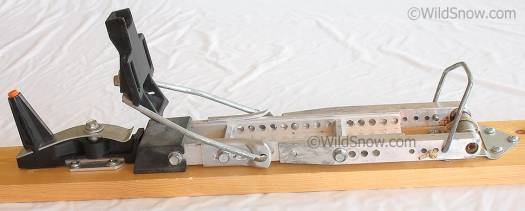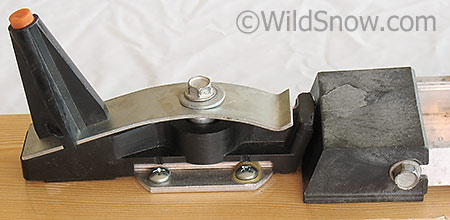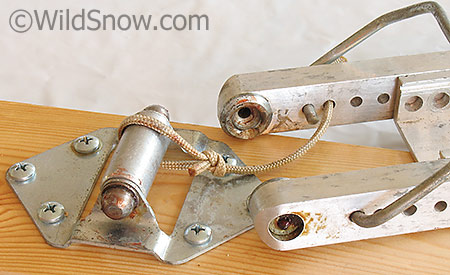Ramer Model R (aluminum) Backcountry Skiing Alpine Touring Binding
(reviewed by Louis Dawson, videography by Louie and Tapley Dawson)
When it was first released in 1974, inventor and engineer Paul Ramer’s “R” model Ramer binding was a revolutionary innovation in alpine ski touring. The R model introduced the concept of a heel lift for climbing, was lighter weight than any other ski touring binding offering of that era, totally field maintainable, and more. Nonetheless, it was inherently flawed and soon made way for better designs.

Ramer model R was good in concept, but lacked an effective release mechanism. Click image to enlarge.
Rig pictured above was not the first production design of the R model Ramer binding, but rather the second. The first was made of plastic where the toe plate screwed to the ski — this broke as soon as they were skied on. More, the heel unit of the original unit lacked the curved metal spring and thus had no tension adjustment and also broke easily.
I was one of the first testers of the soon discontinued plastic version. My trial day dawned bluebird and powdery on Aspen Mountain. In those days you froze for 45 minutes on three chairlifts to reach the top. When I got there after the long ride I was excited to get some powder turns, but three turns later one of my Ramers broke clean off the ski. I walked down the whole 3,000 vertical feet of Colorado magic dust with my planks over my shoulder, listening to the whoops of the powder skiers who’d been smart enough to bring bindings they knew worked.
The Ramer backcountry skiing binding was soon improved with more steel and aluminum, becoming the unit shown in the photo above. Other than being a test victim, I had my own small part in designing the updated unit. I couldn’t get rid of vertical heel pre-release, and the rotating heel unit kept breaking, so while working as a gopher for distributor Company-3 in Aspen I made a spring out of a paint scraper and bolted it on top of the heel piece. It worked, Paul Ramer saw what I’d done, and my idea became part of his binding design.
That wasn’t the end of my tumultuous relationship with Ramer ski touring bindings. Short on cash and high on mountaineering, I tended to use my Ramer touring gear at the ski resort despite a known lack of full safety release. One fine March day in 1977, I dived off the backside of Aspen Mountain for a backcountry run on my Ramers and spiral fractured my left tibia. The bindings didn’t release when my ski tip caught in a clump of willows.
The most severe problems with the model R release were caused by the use of aluminum for the two thick “spring bars” you can see in the photo above. Lateral release is supposed to occur when these bars spring apart and allow the front ball/socket joint to come apart. This works if the binding set at a somewhat low release tension. But because aluminum has little “snap” the model R didn’t absorb sideways forces well (it didn’t have good “return-to-center”) and had unacceptable pre-release at lower settings. More, when you tried to tour, if your release was at a safe level for skiing you’d walk out of the binding after a few steps. Adding insult, you had to keep the ball/socket joint greased, or you’d soon have a binding with no safety release whatsoever. Thus, Ramer users of the day (myself included) tended to set their release dangerously high. But there were more problems than that.
Beyond materials, these types of Ramer bindings had another flaw in the release mechanism. As you took a twisting forward fall, the black plastic cap on the rear of the binding plate would jam up against the heel latch as it was forced upwards, thus obviating any smooth side release.
Later model Ramer bindings such as the Universal, Comfort and MT-2000 all used steel spring bars and had much better release characteristics, though they were still temperamental.

Ramer heel latch detail. You rotate the oblong black plastic unit to change modes. See video below. This part of the binding also provides upward (vertical) release.

Toe ball & socket combined touring pivot with attempt at safety release. Great concept, but real-world performance was underwhelming. String tied through binding is the runaway safety strap.
See videos below to help understand aspects of Ramer model R Alu.
Weight: 30.7 oz, 870 g (one binding, with screws)
These bindings were donated to the collection some time ago, and we’ve forgotten who supplied them. If the person who provided these will contact us we’ll add their credit to this display.

Ramer Model R Alu thumbnail.
